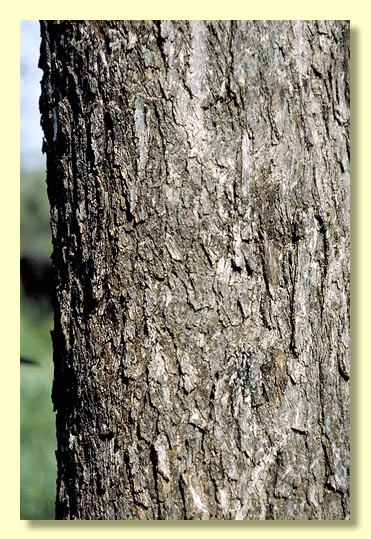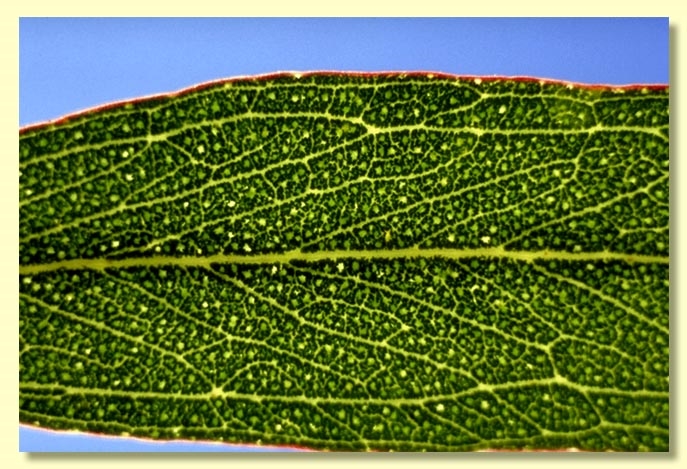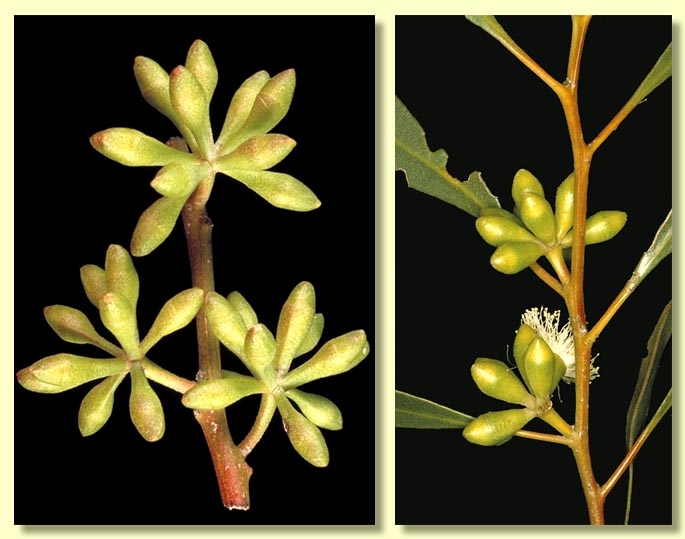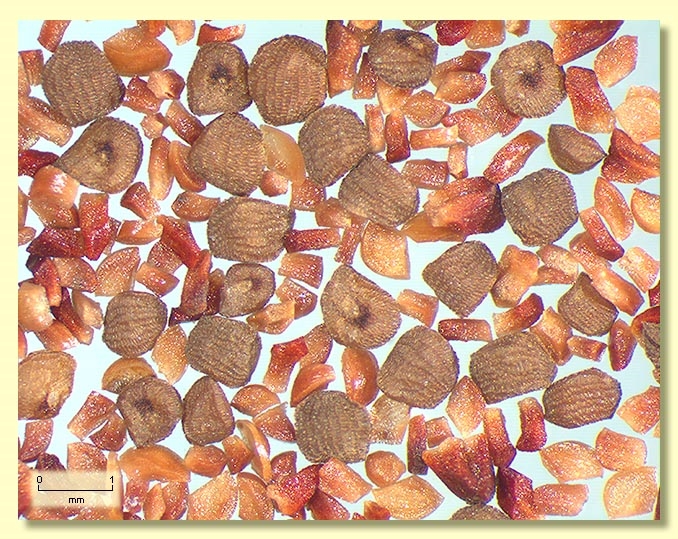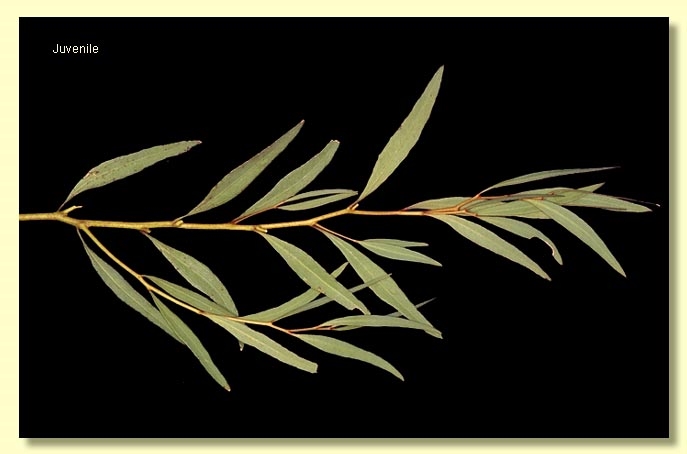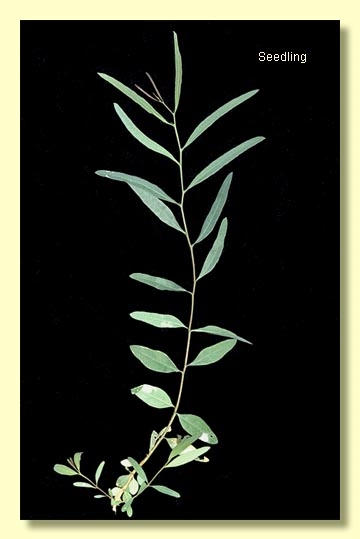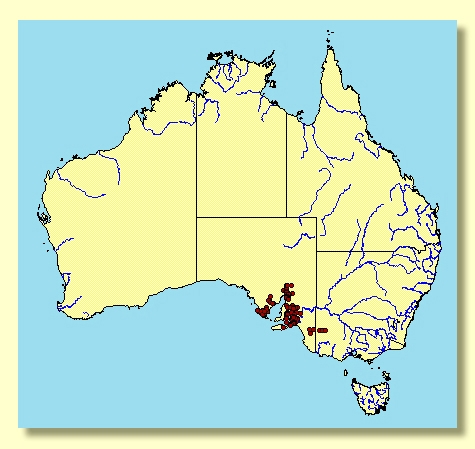Euclid - Online edition
Eucalyptus odorata
Eucalyptus | Symphyomyrtus | Adnataria | Apicales | Buxeales | Continentes
T: Aldenhoven Estate, S.A., H.Behr s.n.; holo: HAL, fide C.D.Boomsma, Trans. Roy. Soc. S. Australia 93: 159 (1969).
Eucalyptus cajuputea F.Muell. ex Miq., Ned. Kruidk. Arch. 4: 126 (1856). T: Flinders Ra., S.A., Oct. 1851, F.Mueller s.n.; iso: MEL, NSW.
Eucalyptus odorata var. erythrandra F.Muell. ex Miq., op. cit 129. T: Port Lincoln, S.A., F.Mueller s.n.; herbarium not known.
Eucalyptus fruticetorum F.Muell. ex Miq., op. cit 131. T: Murray R., Vic., F.Mueller s.n.; herbarium not known.
Eucalyptus odorata var. refracta Blakely, Key Eucalypts 226 (1934). T: near Beaumont, S.A., 21 May 1911, J.B.Cleland s.n.; holo: NSW.
Eucalyptus odorata var. angustifolia Blakely, Key Eucalypts 226 (1934). T: Port Lincoln to Coffins Bay, S.A., Jan. 1907, J.H.Maiden s.n.; holo: NSW.
Bark rough on trunk and on branches to 5–10 cm diameter, tightly held box-type on larger stems, dark grey or grey-brown, smooth bark on branches grey, coppery or brown; branchlets with or without pith oil glands.
Juvenile growth (coppice or field seedlings to 50 cm): stem usually rounded in cross-section, rarely glaucous; juvenile leaves always shortly petiolate, opposite for 5–8 nodes then alternate, lanceolate to narrowly so, 4–10.5 cm long, 0.4–2.3 cm wide, green or grey-green.
Adult leaves alternate, petiole 0.5–1.5 cm long; blade lanceolate to narrowly so, 5.5–14 cm long, 0.6–2 cm wide, base tapering to petiole, concolorous, at first dull blue-green, maturing glossy, green, side-veins very acute, sparsely to moderately reticulate, intramarginal vein parallel to and usually just within margin, oil glands island or obscure.
Inflorescence axillary unbranched, peduncles 0.5–1 cm long, buds 7, 9 or 11 per umbel, sessile or with pedicels 0.6 cm long. Mature buds fusiform to ovoid, 0.4–0.8 cm long, 0.2–0.4 cm wide, green to yellow rarely slightly glaucous, scar absent (both opercula held until flowering), operculum conical to beaked, stamens irregularly flexed, anthers adnate, globoid, cuneate or cuboid, dehiscing by small lateral pores, style long, stigma blunt or pin-head shaped, locules 4 or 5, the placentae each with 4 vertical ovule rows. Flowers white.
Fruit sessile or with pedicels to 0.5(0.8) cm long, cylindrical or barrel-shaped, 0.4–0.8 cm long, 0.4–0.7 cm wide, sometimes weakly anguled, disc descending, valves 4 or 5, near rim level or enclosed.
Seeds brown, 1–1.8 mm long, ovoid or flattened-ovoid, dorsal surface shallowly reticulate, hilum ventral.
Cultivated seedlings (measured at ca node 10): cotyledons reniform to oblong; stems rounded or square in cross-section; leaves always petiolate, opposite for 4–6 nodes then alternate, linear to narrowly lanceolate (5)7.5–14 cm long, 0.7–1.5(2.5) cm wide, dull, green.
Flowering has been recorded in March, April, May, June, July, August, September and October.
A mallee or small box tree scattered through south-eastern South Australia from the eastern Eyre Peninsula, southern Flinders Range to the Mt Lofty Range and Fleurieu Peninsula, Kangaroo Island and east and south-east towards Bordertown and on to adjacent areas of Victoria. It has rough bark to the branches and narrow adult and juvenile leaves. The buds are borne in simple umbels in the leaf axil, and individual buds may be weakly angled.
Eucalyptus odorata is most likely to be confused with another narrow-leaved box species, E. viridis, but this has less rough bark, greener adult leaves and slightly smaller buds and fruit. It is also similar to a third mallee-box species, E. polybractea, but this has glaucous branchlets, buds and young fruit, and bluish to glaucous adult leaves. E. odorata differs from the widespread woodland tree E. microcarpa (Grey box) by the axillary inflorescences (always terminal in E. microcarpa) and the adult leaves which are firstly bluish green and then mature glossy green. E. albopurpurea has terminal inflorescences often with variably coloured flowers (white only in E. odorata) and broader adult leaves while E. porosa has broader leaves with more prominent venation, more distinctly pedicellate buds and fruit with four or five valves (three or four in E. odorata). The hypanthium (base of the bud) of E. odorata may be slightly angled.
In the classification of Brooker (2000) Eucalyptus odorata belongs in Eucalyptus subgenus Symphyomyrtus section Adnataria because the buds have two opercula, ovules are in four rows, seeds are flattened-ovoid, cotyledons are reniform, and anthers are rigid on the staminal filaments. Within section Adnataria, E. odorata is part of a subgroup, series Buxeales subseries Continentes, further distinguished by having buds that retain the outer operculum until flowering time when both opercula are shed together. Most species in this group are from eastern Australia and have all stamens fertile and are woodland trees of hills and plains, often dominant in the landscape, viz. E. albens, E. moluccana, E. microcarpa and E. pilligaensis. Others, viz. E. viridis, E. polybractea, E. froggattii, E. odorata, E. albopurpurea, and E. porosa, are mallees, some of them also occurring as small trees occasionally.
Nicolle in his recent book "Native eucalypts of South Australia" (2013, pp. 186-187) resurrects the name E. cajuputea F.Muell. ex Miq., applying it to green-leaved mallee boxes growing on rocky hill sites on the northern Eyre Peninsula, Flinders Ranges and Mount Remarkable. Historically E. cajuputea has been synonymized with E. odorata, including in EUCLID. Nicolle also makes a comment about the similarity between E. cajuputea and E. wimmerensis Rule from the Little Desert of Victoria and adjacent areas. The treatment of species of green-leaved mallee box species in EUCLID needs to be reconsidered in light of this.


